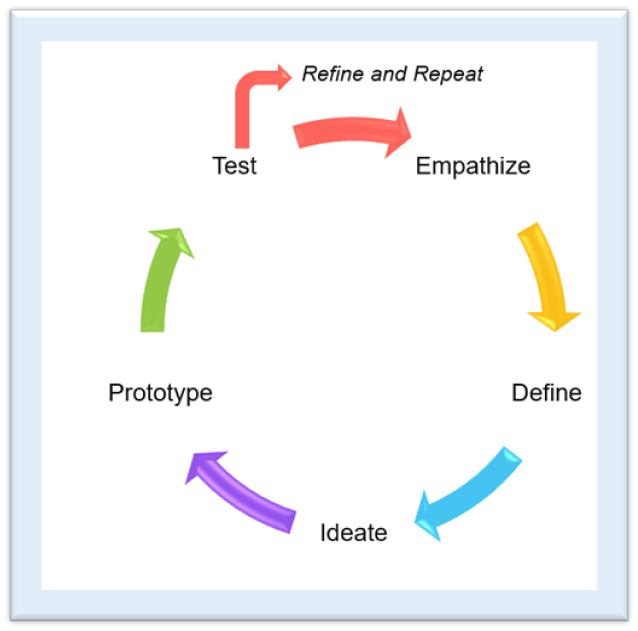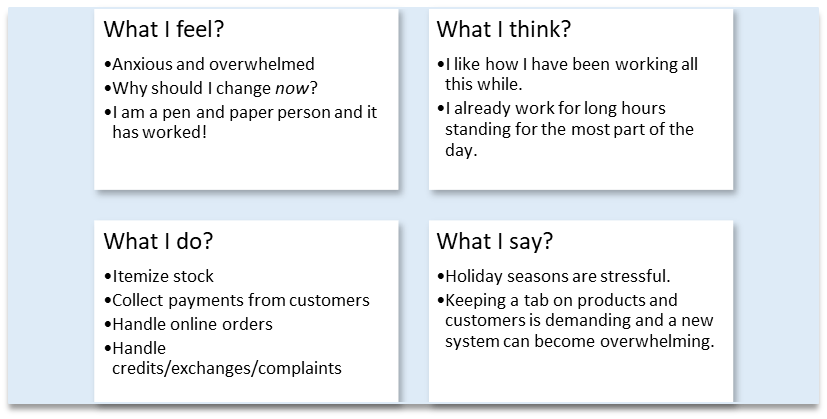Design Thinking in Daily Life
Have you ever wondered why the tables at Starbucks are circular? Are there reasons that lie beyond the obvious? Well, if you’re still wondering, let’s clarify! Starbucks generally uses circular tables, so their single customers feel less alone! This is a classic example of design thinking.
Let’s consider another one. Did you know that escalators have a component called “skirt deflectors,” which minimize the risk of objects or clothes getting trapped between the steps and the sides of the escalator?
If we observe our surroundings, we can see examples of object design where the needs we state or even fail to state as end users have been predicted, designed, and met. Yet another example is Netflix. What began as a competitor to Blockbuster has continued to thrive because it reinvents itself repeatedly. It all started because Reed Hastings was unwilling to pay late fees for a delay in returning a DVD – an inevitable experience among consumers who borrowed DVDs in the early 2000s.
Netflix revolutionized the home entertainment market by providing on-demand streaming for internet users. Users no longer had to contend with time-consuming store visits and high late fees. Instead, Netflix's subscription pricing model, AI-driven recommendations, and interface features like auto-playing trailers was a welcome break from the traditional DVD experience, which had neither a catalog nor personalized suggestions. 1
Design Thinking in Daily Learning
Taking this example further, organizations now provide “the Netflix style of learning”: 2 personalized learning to employees. Learning paths are created for each employee based on their role, job functions, personal aspirations or goals, and the training content they viewed earlier.
Amidst the momentum these ideas are gathering, learning has transcended the structured classroom environment. The boundaries between work and learning, once clearly defined, have now become more fluid. Learning is now an integrated and continuous process embedded in one’s daily work context and routine. From a technological point of view, we are stepping away from the traditional corporate learning portals and are slowly moving towards Learning Experience platforms and from push to pull or self-directed learning.
From a cognitive and neuroscience point of view, we are now compelled to acknowledge that the learner’s brain is not “an assembly line but a marketplace” 3, with multiple events happening simultaneously. A learner’s cognitive bandwidth can become diluted as the learning happens in the workplace. When multitasking, notifications, emails, and other personal and professional situations that fall into the important and urgent quadrant may take precedence over learning.
Our brains are trained to respond to every stimulus, regardless of its importance. As a result, attention could be easily diverted, chances to reflect on consequences may decrease, and many actions may occur without much deliberation. Attention, focus, reflection, practice, and feedback are the mental assets needed for our learning to last longer.
Along with a human-centered focus on design, this blog explores how design thinking in writing, presenting, and delivering content can help build learning situations where designers are developing their abilities rather than completing yet another compliance task.
Design thinking goes beyond how learning products and services are designed, created, packaged, or sold. In this case, it can be used to shape and enhance the overall learning experience.
The design thinking process consists of five phases that involve taking a proactive interest to develop a deeper understanding and empathy for the people for whom the product, service, or experience is created. In each step, the aim is to make the experience more and more tangible so as to facilitate communication, feedback, and improvement.

Figure 1: Standard Design Thinking Process
Empathize: Learning designers often receive the source content and information, such as the target audience, seat time, and expected visual approach. With this information, they proceed to start creating the desired learning intervention. Also, most often, designers meet the client SPOCs or the Subject Matter Experts (SMEs) who represent the learners and not the actual learners themselves. Learners are, therefore, often reduced to a faceless mass sitting at their workstations and working through the learning intervention. To address this gap, we need to delve deeper and move beyond the traditional analysis. We can conduct attitude research, build a learner persona, and create an empathy map. A learner persona is a fictitious person who symbolizes the collective characteristics of a whole group.
For example, the need for new software application training might have arisen as a part of digital transformation, and successful adoption of this software might be the key to faster business results. In this scenario, going beyond the systems training approach, we might also have to address the learner’s preference to stick with the existing process and factor in his/her resistance to change. This is an example of a “wicked” or “ill-defined” problem. Most often, non-consumption or passive consumption is another problem. For example, it could be a person who has been performing these tasks manually before migrating to systems or a retail store worker who is new to the omnichannel payment experience. They may still prefer the older and more familiar ways of working. How do we address this fear of change?
An awareness video covering the benefits of the new system can be rolled out before or as part of the training program and function as the attention hack.

Figure 2: Sample Empathy Map
Define: The aim of this phase is to come up with well-defined problem statements covering the learner’s unmet needs. It is often said that training is not the only solution to all performance problems. Yet, after thorough research with added perspectives and empathy, we can narrow training needs to specific performance gaps. A well-defined problem statement will always lead to a measurable performance goal.
Let’s continue with the above example of a retail store worker who has been working long hours and is familiar with other facets of work and processes. What would be the ideal approach here? Action mapping is one way to define a problem and a solution, as it involves stripping down the training to cover only the essential real-world tasks, avoiding content dumping, and providing resourceful job aids.
Ideate: This is the stage where problem-solving begins. Involving a cross-functional team will be beneficial, as it will generate more ideas. Online mind-mapping platforms are better than whiteboards and papers for brainstorming and solving multi-faceted, ever-changing, and complex problems. Further, it provides a single platform for all the teams to stay aligned with updated ideas and solutions.
For this example, we can create a learner’s journey from logging onto the system, empathize with their daily work schedule, and address their need for accessing the latest help guides to accomplish their tasks just in time and at the place of need. A digital adoption platform or a knowledge base with searchable quick reference guides are great performance support examples that can be integrated into the systems learners will use to work.
Prototype: Prototyping, or even innovation for that matter, does not always involve using the latest technology. A great example of this would be the country of Panama, which broadcast shared lessons on national television during the COVID-19 pandemic. 4
Prototyping is all about curating your best ideas from the previous stages and providing a physical shape to these ideas. The only intent of this stage is to generate useful feedback and build a portfolio of solutions characterized by diversity, low fidelity, and just the right amount of usefulness to facilitate discussion and refinement. The prototypes of learning interventions usually include mockups that represent the proposed instructional and visual strategy.
Test: Again, test the best solutions with a focus group that best represents the learners. The results of the testing phase can lead to deeper insights into the learner’s experience and can further be used to refine the approach.
Most often, we work on agile projects that need rapid implementation. In contrast, design thinking involves deliberation, exploration, and experimentation at each process step. So, how do we achieve a learning outcome that is well-designed and yet rapidly developed and deployed?
Incorporating design thinking with simple practices, even at the initial content authoring level, is possible without resorting to high-tech solutions. For example, as a learner or viewer of any experience, we pay more attention to changes or novelties, beginnings, and endings.
There are many simpler ways to introduce novelty into the learning process, such as adding storytelling with conflict points where learners can provide resolution, adding countdowns to a quiz, providing a web quest game to motivate the learner to refer additional resources, etc. We can leverage AI conversational agents to provide opportunities for the learners to reflect on what they have learned. Riff.AI is a reflective AI tool that can add to the learning experience.
Conclusion
Design thinking is a starting point for the emerging trend of Learning Experience Design and can add significant value to the instructional design process. Perhaps the first step is to view design thinking not as a downstream step or cosmetic add-on later in the learning design process but to put the real beneficiaries, that is, the learners, into the center of the action. Instead of seeing learning as merely content, presentation, and assessment, we can identify the goals or tasks that the learners want to accomplish while taking their circumstances into account and build an engaging experience for them.
Acknowledgment
This piece was written by Pavithra M at Encora.
About Encora
Fast-growing tech companies partner with Encora to outsource product development and drive growth. Contact us to learn more about our software engineering capabilities.
References
- Experience Point (2019, May 30). How Netflix Used Design Thinking to Reinvent Itself, Over and Over. Design Thinking Association. Retrieved August 17, 2023, from https://blog.experiencepoint.com/how-netflix-uses-design-thinking
- Munir, M. (2021, June 16). What is the Netflix style of learning and how can it benefit L&D teams? Digits: A Ciphr Company. Retrieved August 17, 2023, from https://www.digits.co.uk/news/what-is-the-netflix-style-of-learning-and-how-can-it-benefit-ld-teams/
- Eagleman, D. (2012). Incognito. Penguin Random House. https://www.penguinrandomhouse.com/books/44457/incognito-by-david-eagleman/
- Stolzoff, S. (2020, June 30). How Would You Reimagine Learning? 5 Visions for Our Post-COVID Future. Ideo.com. Retrieved August 17, 2023, from https://www.ideo.com/blog/how-would-you-reimagine-learning-5-visions-for-our-post-covid-future